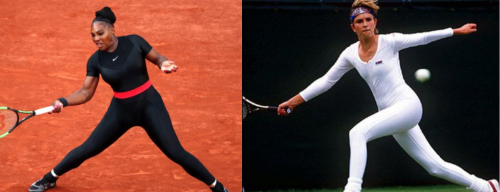Many tennis clubs today uphold an all-white dress code. But does this homage to tradition come with the racism and sexism of the past? Wimbledon’s achromatic clothing policy hearkens back to the Victorian era, when donning colorless attire was regarded as a necessary measure to combat the indecency of sweat stains, particularly for women. Of course, back then, women customarily played tennis in full-length skirts and men in long cotton pants — also for propriety’s sake.

But today, not all tennis clubs insist on all-white.While Wimbledon is known for having the strictest dress standards (even Anne White’s catsuit pictured above got banned there in 1985), the other grand slams, including the French Open (along with the U.S. Open and the Australian Open), have recently become venues for athletes to showcase custom fashions in dramatic colors and patterns. Since the advent of color TV, athletes have used their clothing to express their personality and distinguish themselves from their competitors.
For instance, Serena Williams wore a black Nike catsuit to this year’s French Open. Her catsuit, a full-body compression garment, not only made her feel like a “superhero,” but also functioned to prevent blood clots, a health issue she’s dealt with frequently and which contributed to complications with the birth of her daughter. On Instagram, she dedicated it to “all the moms out there who had a tough recovery from pregnancy.”
Despite this supposed freedom, Williams’ catsuit drew the ire of the French Tennis Federation. Its president, Bernard Giudicelli, said in an interview with Tennis Magazine that “[Catsuits] will no longer be accepted.” The FTF will be asking designers to give them an advance look at designs for players and will “impose certain limits.” His rationale? “I think that sometimes we’ve gone too far,” and “One must respect the game and the place.”
The new policy and the coded language Giudicelli used to justify it have been called out as both racist and sexist. By characterizing Williams’s catsuit as a failure to “respect the game,” the FTF echoes other professional sporting associations who have criticized Black football players kneeling during the anthem and Black or Latino baseball players’ celebrating home runs. Moreover, the criticism of Williams’ form-fitting clothing and the reactionary new dress code it spawned are merely the latest in a series of critiques of Williams’ physique.
Sociologist Pierre Bourdieu explains in his “Program for a Sociology of Sport” that practices like the policing of athletes’ apparel are a way for the tennis elite to separate themselves from other players and preserve a hierarchy of social status. This became necessary as the sport, derived from royal tennis and known as the “Sport of Kings,” experienced a huge increase in popularity since the 1960s. Bourdieu describes how this expansion resulted in a variety of ways to play tennis, some more distinctive than others:
…under the same name, one finds ways of playing that are as different as cross-country skiing, mountain touring, and downhill skiing are in their own domain. For example, the tennis of small municipal clubs, played in jeans and Adidas on hard surfaces, has very little in common with the tennis in white outfits and pleated skirts which was the rule some 20 years ago and still endures in select clubs. (One would also find a world of differences at the level of the style of the players, in their relation to competition and to training, etc.)
In reanimating the dress code, FTF officials are engaging in boundary work to preserve the status of a certain kind of tennis — and, by extension, a certain kind of tennis player — at the top of the hierarchy. In so doing, it is limiting the expression of a sports icon who redefines beauty and femininity and perhaps elite tennis itself.
Amy August is a doctoral candidate in Sociology at the University of Minnesota. Her research focuses on education, family, culture, and sport. Her dissertation work uses qualitative methods to compare the forms of social capital recognized and rewarded by teachers and coaches in school and sports. Amy holds a BA in English Literature from the University of Illinois at Chicago, a MA in Teaching from Dominican University, and a MA in Comparative Human Development from the University of Chicago.

Comments 5
a — September 25, 2018
Ms. White was told she couldn't wear that outfit again: https://www.washingtonpost.com/archive/lifestyle/1985/06/29/bodysuit-bites-the-dust/e602f07d-2402-44ca-98f2-76f65326566b/?noredirect=on&utm_term=.6d3992100c0f
Amy — September 28, 2018
Thanks for the link! I've updated the post to include this information.
Aliyavictor — November 18, 2021
An activity that has grown in popularity over the past several years is table tennis , also known as ping pong. This game can be played by two or more people and can be played for fun or competitively, depending on your preference.
Larry Jacobs — December 23, 2021
Thank you for sharing this good post about the tennis dress code. Nowadays most tennis clubs will require you to wear short-sleeved cotton tops and matching tennis shorts and women may also wear tennis skirts with built-in shorts or one-piece suits, which are quite fashionable. I have also played the tennis game when I was a college student. Now I am a professional online gamer who is interested to make money by playing online games. Recently My friend suggest me this website casinosters.com where I have found top online casinos which offer bonuses and accept Siru mobile payment that can help to win money by playing different types of online casino games. i believe the online casino is one of the best ways to earn money online. So Interested people can check the resource.
Charles Mayor — February 19, 2023
How do you start playing a casino game? As a newbie, I want to dive there. Do you have any suggestion?